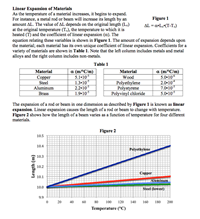 Linear Explansion of Materials
Linear Explansion of Materials
Resource:
The Science Reasoning Center: Linear Expansion of Materials
Grade Level: High School
Description:
This passage describes in quantitative terms the linear expansion that materials undergo when heated. The passage includes an equation, a table of coefficients of expansion, and a graph. Questions target a student's ability to use an equation to make predictions, to draw conclusions that are consistent with a model, to select points on a graph, to combine data from a table and a graph in order to compare the expansion of a material under various circumstances, to extrapolate outside the range of values provided by a graph, and to combine data from a table and a graph to make predictions about the amount of expansion a given length of material would undergo.
Performance Expectation:
HS-PS2-6 Communicate scientific and technical information about why the molecular-level structure is important in the functioning of designed materials.
This activity aligns with the three dimensions of the Next Generation Science Standards in the manner described below:
| Structure and Properties of Matter (HS-PS1.A.3): The structure and interactions of matter at the bulk scale are determined by electrical forces within and between atoms. |
The expansion of matter as a function of temperature is a very important property for engineers designing structures. On a regular basis, structural, civic, and even electrical engineers take this property of matter into consideration. While not explicitly addressed within this passage, by considering that non-metals have coefficients of linear expansion much different from those of the metals studied, the reader may come to the conclusion that the expansion rate at the bulk scale is determined by interactions occurring at the atomic scale. |
| Stability and Change: Much of science deals with constructing explanations of how things change and how they remain stable. |
This passage explores the linear expansion of common materials as a function of temperature. For each of the materials considered, as temperature increases the length of a sample of that material also increases. While there are many properties of substances that change with temperature, studying the expansion of matter with increased temperature at the macroscopic scale is not only something the reader has experienced it is also a relatively straightforward phenomenon that students can model mathematically. |
| Energy and Matter: Changes of energy and matter in a system can be described in terms of energy and matter flows into, out of, and within that system. |
As energy is added in the form of heat, objects typically expand in size. Conversely, as energy leaves a system and its temperature drops, the object contracts. This passage allows the reader to consider this relationship both algebraically and graphically. As there are many real-world implications for this relationship, such connections between energy and the physical properties of matter are studied by engineers and scientists alike. |
| Analyzing and Interpreting Data: Analyze data using computational models in order to make valid and reliable scientific claims. |
This passage requires the reader to quantitatively investigate the linear expansion of various materials when heated. The passage and the questions that follow ask students to apply an equation, to use a data table to interpret the role of the coefficients in a material’s expansion, and to identify the physical meaning of the slope on a graph. |
| Engaging in Argument from Evidenc: Make and defend a claim based on evidence about the natural world that reflects scientific knowledge, and student-generated evidence. |
Questions at the close of the passage ask students to engage in argument from evidence as they make predictions and draw conclusions that are consistent with a model. Students are asked to use their knowledge of the collected data to predicted behaviors beyond the range of data given and defend claims regarding why materials graphed do not have the same slope. |
| Using Mathematical and Computational Thinking: Use mathematical representations of phenomena or design solutions to describe and/or support claims and/or explanations. |
In this passage students will use an equation along with a graph showing the rate of linear expansion for four materials to predict the lengths of a beam at various temperatures. They will see that the linear equation provided is the same equation used to graph the length of these materials at various temperatures. As they do, students are using quantitative representations of phenomena to support claims and explanations made. |
View Infographic.
(Coming Soon)
Search the NGSS Corner
Maybe you're looking for something really specific that pertains to a desired topic and emphasizes one or more of the listed NGSS dimensions. Why not try a search of this section of our website? Simply select from one or more of the pull-down menus and click Search This page will reload and a collection of possibilities will be displayed in this section of the page and sorted by relevancy.